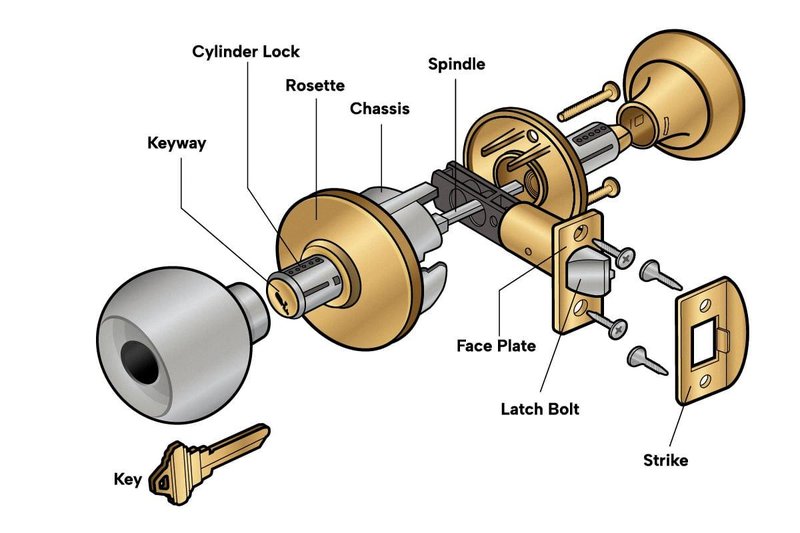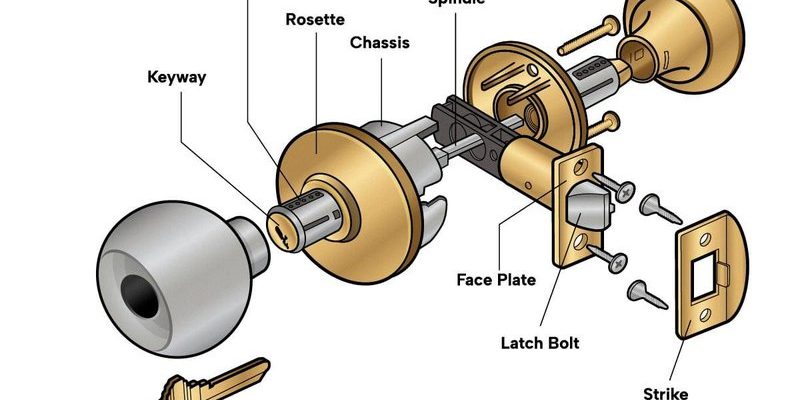
Now, understanding how a door latch mechanism functions might seem a bit daunting at first. But don’t worry! It’s actually pretty simple once you break it down and take a closer look. Let’s dive into the nitty-gritty details while keeping things casual. By the end, you’ll not only know what makes your door latch tick but also be able to troubleshoot common issues you might encounter.
What Is an Interior Door Latch Mechanism?
An interior door latch mechanism is essentially the system inside your door that allows it to open, close, and stay securely shut. Think of it as the unsung hero of your home, quietly working behind the scenes. It’s the mechanism that engages when you turn the doorknob and disengages when you twist it back to open the door.
Typically, an interior door latch consists of several key components: the latch bolt, the strike plate, and sometimes a deadbolt. The latch bolt is most responsible for gripping the strike plate (the metal plate mounted on the doorframe), keeping your door locked in place when shut. When you turn the knob, the latch retracts, allowing the door to open freely.
Understanding this mechanism is important because it can help you troubleshoot issues when your door doesn’t close properly or when the latch gets stuck. Knowing how it works empowers you when it’s time to make repairs or upgrades.
Key Components of a Door Latch Mechanism
Let’s break down the individual components of a typical interior door latch mechanism. Each part has a specific role, and together, they ensure everything functions smoothly.
- Latch Bolt: This is the main part that extends and retracts when you turn the doorknob. It’s usually spring-loaded, meaning it pops back into position to keep the door closed.
- Strike Plate: This metal plate is attached to the doorframe. The latch bolt catches onto this plate when the door is closed, securing it in place.
- Doorknob/Lever: When you turn the doorknob or pull the lever, it activates the latch bolt to either engage or disengage.
- Deadbolt (optional): Some interior doors have a deadbolt for extra security. This is essentially a thicker bolt that locks into place for better safety.
Each of these components works together in a coordinated dance to keep your door functional. When one part starts to wear out, it can cause the entire system to malfunction, which can lead to inconvenience or frustration.
How Does the Latch Mechanism Work?
Now that we’ve covered the components, let’s take a look at how they work together in action. Imagine you’re entering a room, and you reach for the doorknob. When you turn the knob, you’re not just engaging a simple mechanical action; you’re activating a series of movements in the latch mechanism.
When you twist the knob, it pushes a spindle connected to the latch bolt. This spindle pulls the latch bolt back into the door, allowing it to clear the strike plate. Once the bolt is fully retracted, the door swings open. When you release the knob, the spring mechanism pushes the latch bolt back out, securing the door again.
It’s all about that seamless coordination. If any part of this mechanism is damaged or worn out, you might find yourself wrestling with the door or, worse, locked out!
Common Issues with Interior Door Latch Mechanisms
Despite their robust design, interior door latch mechanisms can encounter problems over time. Knowing what to look for can save you a lot of hassle. Here are a few common issues:
- Sticking Latch: If the latch bolt doesn’t easily retract, it might be due to dirt buildup or a misaligned strike plate. A quick cleaning or adjustment can fix this.
- Loose Knob: Sometimes, the knob can become loose over time, affecting how well it engages the latch. Tightening or replacing the screws can solve this issue.
- Worn-out Components: If you notice the door isn’t securing as well, the latch bolt or internal springs may need replacement. Regular checks can help you catch wear and tear early.
Understanding these issues helps you be proactive. After all, a small problem can become a significant headache if left unaddressed.
Choosing the Right Latch for Your Needs
If you find yourself needing a replacement or upgrade, it’s essential to choose the right latch for your door. Interior door latches come in various styles and security levels. Here are a few things to consider:
1. Type of Door: Are you working with a lightweight interior door, or do you need something sturdier? Lighter doors might only require a basic latch, while heavier ones may need a stronger mechanism.
2. Security Features: If you want something more secure, consider a latch with a deadbolt feature. This adds that extra layer of safety, perfect for bedrooms or home offices.
3. Style: Latches come in different designs and finishes. Make sure the latch you choose complements your door and overall home decor.
Let’s not forget about universal latches. They are adjustable and fit a variety of door types, making them a flexible option if you’re unsure what you need.
Maintaining Your Door Latch Mechanism
Once you’ve got your interior door latch mechanism set up, maintaining it is crucial for longevity. Here are some tips to keep everything running smoothly:
– Regular Cleaning: Dust and dirt can accumulate over time. Wipe down the latch and surrounding areas every once in a while to prevent buildup.
– Lubrication: Applying a bit of lubricant to the latch bolt and hinges can help ensure smooth operation. A silicone-based spray is an excellent choice for this.
– Check for Misalignments: Periodically check if the latch aligns correctly with the strike plate. If not, you might need to adjust the hinges or the strike plate to ensure a snug fit.
Maintaining your door latch not only preserves its function but also extends its life. It’s a small investment in time that pays off in convenience.
The interior door latch mechanism might be a small part of your home, but it plays a giant role in your daily life. By understanding how it works and recognizing common issues, you’re well on your way to becoming a home repair whiz. Whether you’re troubleshooting problems, considering upgrades, or simply keeping your latch well-maintained, you now have the knowledge to handle it all with ease.
So next time you pass through a door, you can appreciate the intricate mechanics at work behind the scenes. Happy door-latching!
